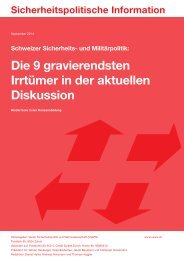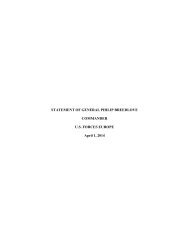FULLTEXT01
FULLTEXT01
FULLTEXT01
Create successful ePaper yourself
Turn your PDF publications into a flip-book with our unique Google optimized e-Paper software.
TACTICAL THOUGHT<br />
2014 September 29 th<br />
Colin S. Gray<br />
In Chapter 6 in Colin Gray’s book, Another Bloody Century, Future Warfare, Irregular<br />
Warfare and Terrorism are discussed 419 . Gray argues that terrorism is a mode of<br />
Irregular Warfare, which in turn is warfare, thus defining terrorists as soldiers. 420 Gray<br />
disagrees with Kiras’ definition of terrorism, and leans on Bruce Hoffman’s (“the<br />
deliberate creation and exploitation of fear through violence or the threat of violence in<br />
the pursuit of political change”). According to Gray, Kiras distinguishes between<br />
terrorism and Irregular Warfare. Gray defines Irregular Warfare as “warfare between<br />
regulars and irregulars” and that is warfare between a state and a non-state adversary.<br />
The legal status of the rival belligerents is the key, not the character of fighting,<br />
according to Gray.<br />
The weak use Guerrilla Warfare and terrorism but later on develop regular war-fighting<br />
capabilities (as Mao). Warfare of all kinds, other than that between states, can be seen as<br />
Irregular Warfare. The ability to turn the opponent’s strengths to his weakness and one’s<br />
own weaknesses (material) to strengths…..a paradox…..a character of Irregular<br />
Warfare. 421 The Irregular warrior needs to behave covertly with stealth, be highly<br />
motivated, possess excellent intelligence and have territorial sanctuary and support,<br />
according to Gray.<br />
“Post-modern Terrorism” (Al Quaida) is, according to Gray, not new, it is terrorism;<br />
Irregular Warfare and warfare. 422 Regular and Irregular Warfare have always coexisted.<br />
423 Gray gives historical examples. A typical trait is said to be that Irregular<br />
Warfare almost invariably makes the regular belligerent use terror against the civilian<br />
populace, who provide, or might provide recruits or support for the guerrillas. The<br />
problem of elusive guerrillas is described. 424 Gray argues for the result potentiality of<br />
harsh means, although it is ethically wrong according to western standards….. ”given<br />
doubt to more half-measured hearts-minds actions”, ”a brutal war” 425 Gray claims the<br />
only new thing is, that the latest technology will permit both irregulars and regulars to<br />
perform their bloody deeds either in new ways or more efficiently in old ways. 426<br />
Referring to Callwell, who “explained for all times”, the key problem of conducting<br />
Irregular Warfare is “the difficulty of persuading or coercing an irregular enemy to<br />
home out and fight so that he could be duly slathered in satisfactorily large<br />
numbers”. 427<br />
419 Colin S. Gray, Another Bloody Century, Future Warfare, (London: Wiedenfeld & Nicolson, 2005), pp.<br />
212-254.<br />
420 Ibid. p. 213.<br />
421 Ibid. p. 215.<br />
422 Ibid. p. 219.<br />
423 Ibid. p. 222.<br />
424 Ibid. p. 223.<br />
425 Ibid. pp. 223-224.<br />
426 Ibid. p. 224.<br />
427 Ibid. p. 224.<br />
54





